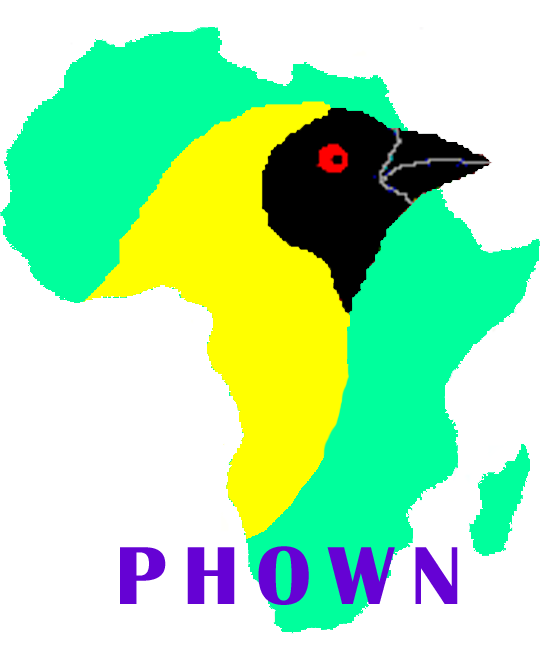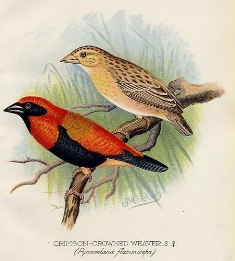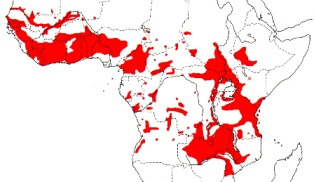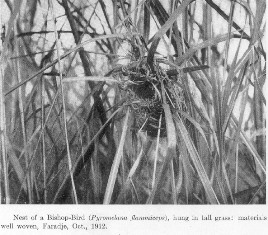Weaver species
Choose different species from drop-down list and press 'Go' button. See Full species list.Black-winged Bishop Euplectes hordeaceus
IUCN: Least concern Discovery: 001Categories: red bishops, Linnaeus, pest,
News items about species
Discovery
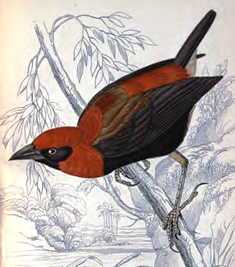
figure from Swainson 1837 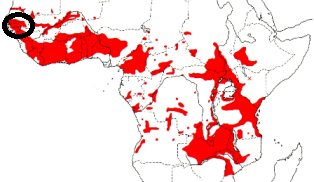
type locality circled 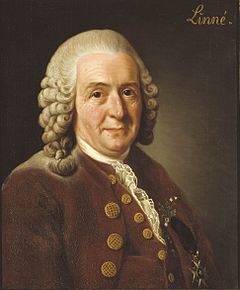
IntroductionLinnaeus thought this species came from India, or the [East] Indies ("in Indiis"), a common mistake in his day, as the ship bringing this specimen probably came from the far East but stopped at African ports along the way, where African specimens could have been added to the cargo. Gyldenstolpe (1924) first noticed the error, and restricted the type locality to Senegal as the type specimen matched other specimens from Senegal.Linnaeus noted the source of the type specimen as "mus ad fr", ie. the Museum Adolphi Friderici, a collection maintained by the King of Sweden, Adolf Fredrik. Swainson (1837) obtained described a specimen from Senegal as a new species (Crimson-crowned Weaver Euplectes flammiceps), but this was later discovered to be the same species as the Black-winged Bishop. Nevertheless, his painting is the first published illustration of this species, many decades after Linnaeus first described it. Scientific citationLoxia hordeacea Linnaeus 1758a Syst. Nat., ed. 10, p173 'in Indiis', errore = Senegal, vide Gyldenstolpe 1924.Meaning of nameshordeaceus (Latin) - of barley; referring to its diet.First English nameYellow-rumped Grosbeak (Latham 1783).Alternate namesFire-crowned Bishop.CollectorUnknown, but kept in the Museum Adolphi Friderici.Date collectedBefore 1754, since Linnaeus studied the collection from 1751-1754.Locality collectedUnknown, type locality restricted to Senegal.Type specimensThe type is in the Swedish Museum of Natural History (Naturhistoriska riksmuseet) in Stockholm. Modern photos of the type are at here. |
The above is based on Weaver Wednesday 2, a weekly series about the discovery of each weaver species.
This species text first appeared as
Weaver Wednesday [118] - Discovery [1]: Black-winged Bishop on 2014-09-17
1. Basic biology
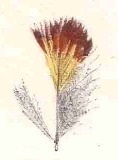
feather, from Rochebrune 1884
Identification
This species was described by Linnaeus, based on a specimen from Senegal, and photos of the holotype may be viewed here.
Distribution
Habitat
Food
Breeding
The nest resembles the nest of the Southern Red Bishop but has a larger side entrance and distinct overhanging porch. The nest is placed in tall grass or coarse vegetation, 0.8-3.0m above ground. It is usually supported by grass stems on either side of the large entrance. During droughts, the first nests are built 3 weeks later than average, and more nests are built in trees than in grass. This species seldom breeds in colonies, and is often solitary or with 2 males close together. The male constructs the nest, and may work on more than one at a time. The female lines an accepted nest with fine grass. Only the female incubates the eggs and feeds the chicks. Nests may be parasitized by the Diederik Cuckoo Chrysococcyx caprius. |
The above is based on Weaver Wednesday, a weekly series about weaver species.
This species text first appeared as
Weaver Wednesday [58]: Black-winged Bishop on 2013-07-24
2. Breeding facts
| Pair bond Polygynous, with up to four females per male Breeding season Jul-Aug in Senegal, Ghana and Togo, Aug-Sept in Mauritania, Mali, Liberia and Burkina Faso, Aug-Nov in Gambia, Sept-Jan in Sierra Leone, Aug-Oct in Nigeria Sept-Dec in Cameroon, and Dec-Jan and Apr on Sao Tome; breeds Aug-Oct in Sudan, and Apr-May and Aug-Oct in Ethiopia; Jan-May in Angola; in DRCongo, Aug-Oct in Uele and Jan-May in S region, Apr-Aug in Uganda, recorded in most months (mainly Apr-Jul) in Kenya, Feb-Jun in Tanzania (during drought, first nests three weeks later than average), but May-Aug on Zanzibar; Jan-Apr in Zambia and Zimbabwe, Feb-May in Malawi and Jan-Mar in Mozmbique Nest site supported 0.8-3.0 m above ground by vertical stems of tall grass or other vegetation; duing drought in Tanzania, more nests built in trees than in grass Nest building built by male, lined by female Colony size Male defends territory of 400-1200 m2. Often solitary nester, sometimes a few males close together Clutch size 2-4 eggs Egg colour light blue-green, rarely with tiny black spots Egg size average size of 17 eggs 18.5 x 13.8 mm (DRCongo) Incubation incubation by female alone, one report of male on nest containing eggs, period 12-14 days Chicks and nestling period chicks fed by female only, nestling period 11-13 days, up to 16 days in unfavourable conditions |
Breeding information based on Handbook of the Birds of the World, Vol. 15.
3. Photos of Weaver Nests
 Vm 5770 |
Thumb-nails of most recent PHOWN records - click on one to see its full record
See all PHOWN records for this species here.
PHOWN (Photos of Weaver Nests) provides valuable info on breeding distribution and colony sizes of weavers.
You can contribute by registering and submitting photos at Virtual Museum webpage.
4. Breeding distribution
Google map showing distribution (For species with small ranges you need to zoom in at the correct area to see the range):
yellow blob - range of weaver species; read more about this here.
![]() - PHOWN records with photos
- PHOWN records with photos
![]() - PHOWN records with no photos (Nest Record Cards, other records)
- PHOWN records with no photos (Nest Record Cards, other records)
![]() - Birdpix records
- Birdpix records
![]() - comments on out of range records, or interesting records
- comments on out of range records, or interesting records
![]() - type locality
- type locality
CLICK on the marker on the map to see individual record details.
5. Range changes
Not South African speciesThe above is based on Weaver Wednesday 3, a weekly series about range changes in South African weaver species.
This species text first appeared as
n/a







